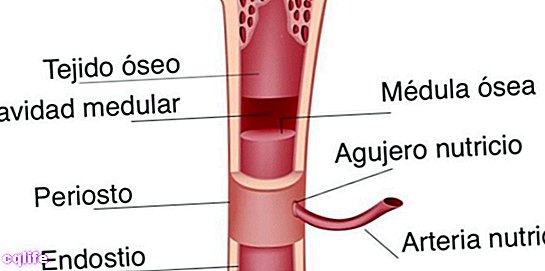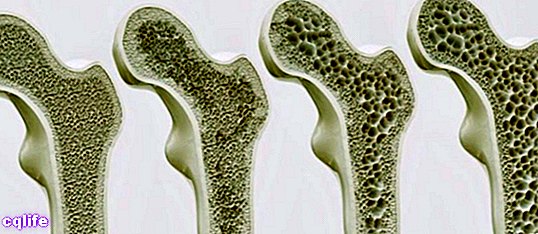- What are bones?
- Types of bones
- Bone function
- Bone structure
- How many bones has the human body?
- Bone diseases
We explain everything about bones, how they are classified, their function and structure. Also, how many bones does the human body have.

What are bones?
The bones are a set of structures rigid organic substances, mineralized by the accumulation of calcium and other metals. They are the hardest and most resistant parts of the human body and other Vertebrate animals (second only to tooth enamel).
The set of all the bones of the body makes up the osseous system or skeleton, physical support of the organism. In the case of vertebrates, this support is found inside the body (endoskeleton), instead of outside (exoskeleton) as in the case of the arthropods and other animal phyla.
In addition, within the bones is the bone marrow, which performs hematopoietic functions or the creation of red blood cells. In other words, it is a set organs with complex functions, which have adipose tissue, blood vessels and even nerves inside.
Bones are much more than simple supporting structures of the body, although we have the opposite idea, surely a consequence of the fact that they are the last thing in the human body to decompose after death.
The bones gradually solidify as the individual grows, during early childhood, and they grow together with him until reaching their final size. Similarly, bones can regenerate their own breaks (fractures) through a process called bone healing, and they are constantly remodeling within the body.
Types of bones
Depending on their shape and appearance, the bones of the human body can be classified into four categories, which are:
- Long bones. As their name suggests, they have a length predominant in width and thickness, and they are dense, strong bones, within which the red and yellow marrow are housed.
- Short bones. These are bones whose three dimensions (length, width and thickness) are practically the same.
- Flat bones. In these bones, length and width predominate over thickness, since they usually constitute the framework of the different body cavities.
- Irregular bones This last category includes all the bones whose shape prevents them from being classified in any of the previous three.
Bone function
Bones fulfill various functions in the body, which can be summarized as:
- They provide structural support to the body, retain their shape, and protect internal organs from the outside.
- The bone marrow produces red blood cells that carry oxygen in the blood.
- Along with muscles, joints, ligaments and tendons, bones allow the movement volunteer of the body.
- Bones are an important storage region for resources, not only calcium and phosphorus, necessary for their hardening, but also certain types of lipids and last minute usage resources.
Bone structure

Bones are made up of three parts, called the diaphysis (central portion of the bone body), the epiphysis (ends of long bones), and the metaphysis (the middle portion of the bone). Similarly, from the inside out, they are made up of:
- Medullary cavity. The "hollow" region of the bone where the bone marrow is housed, generally located in the diaphysis.
- Endosteum It is a thin membrane of conjunctive tissue that lines the interior of the medullary cavity of the long bones.
- Nutritive artery. The artery that supplies blood to the bone, through its nutritional holes and which is then distributed through the bone through increasingly thin capillaries.
- Woven bone. The main component of bone, made up of bone cells (osteocytes, osteoblasts, osteoclasts and stem cells) in 2% of the tissue, and by 70% of resistant extracellular substance (hydroxyapatite) secreted by them, from calcium and phosphorus, plus around 30% collagen.
- Periosto. The tough, fibrous connective tissue membrane that covers bones in its outer region.
How many bones has the human body?
The skeletal system of the human body is made up of 206 different bones, articulated in different ways to cartilage, ligaments, muscles and tendons.
Bone diseases

Like other parts of the body, bones can be injured (fractures, trauma) or they can be the victims of disease. The best known of these are:
- Cancer. Bone marrow cancer occurs, like other tumors, by the abnormal multiplication of cells in its soft part (tumors called myelomas), or sometimes between hardened cells in its rigid part (called sarcomas). It leads to weakening of the structure and painful local numbness.
- Osteoporosis. This disease consists of a chronic loss of calcium in the bones, causing them to lose weight and increase their fragility. It is closely associated with advanced age and other processes of the body, so it requires a combined treatment, through calcium supplements and physical exercise.
- Paget's disease. This is the name of a congenital ailment, which causes abnormal function of the cells that originate the bone, causing an abnormal thickening and widening of the skeletal structure, which threatens the Health of the patient.
- Rickets. A disease derived from the deficiency of vitamin D in the diet, or also of some endogenous problem that prevents the absorption of said nutrient, essential for the calcification of the bones. For this reason, people afflicted with this disease suffer from a progressive weakening of the bones, which thus become painfully fragile and brittle.
